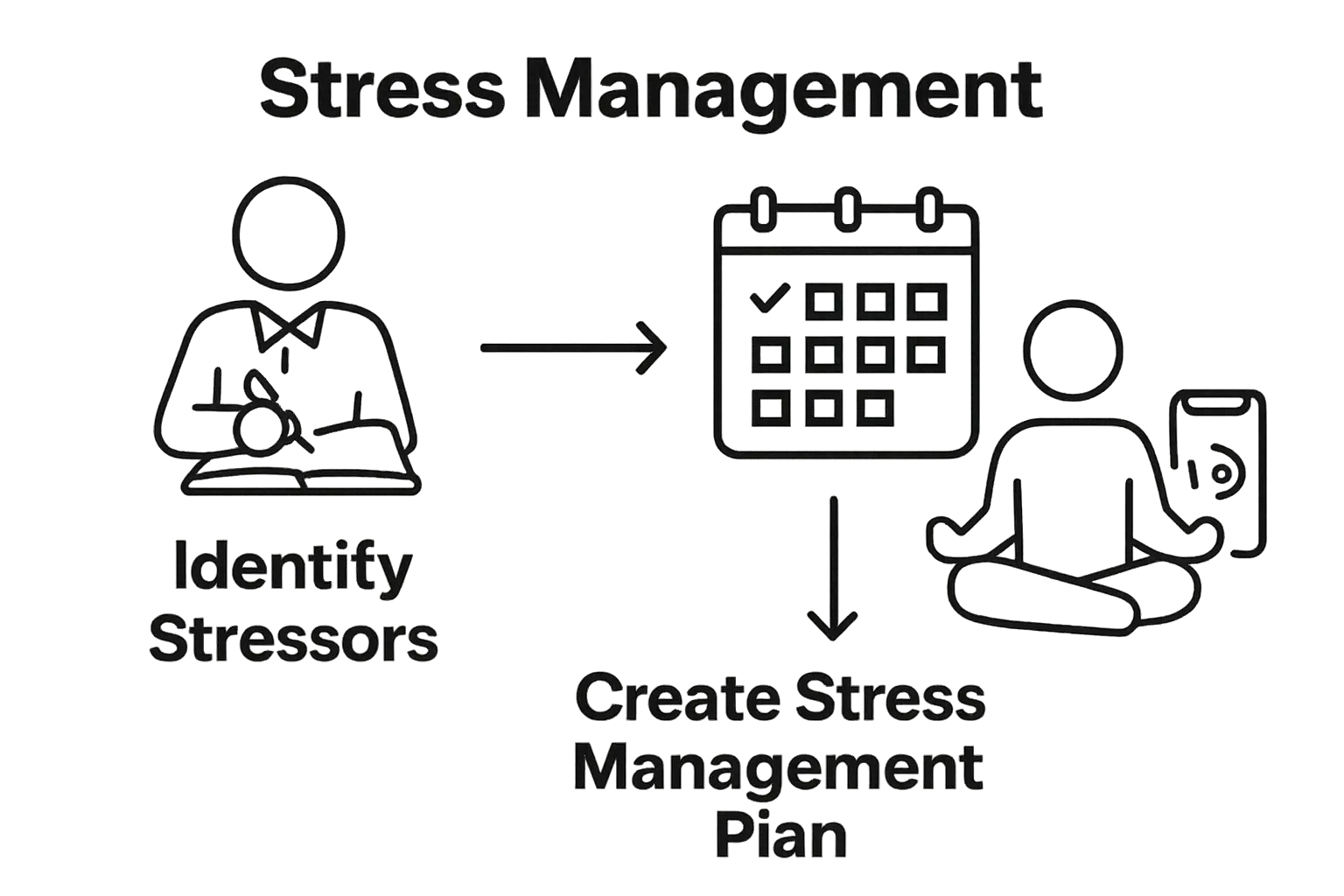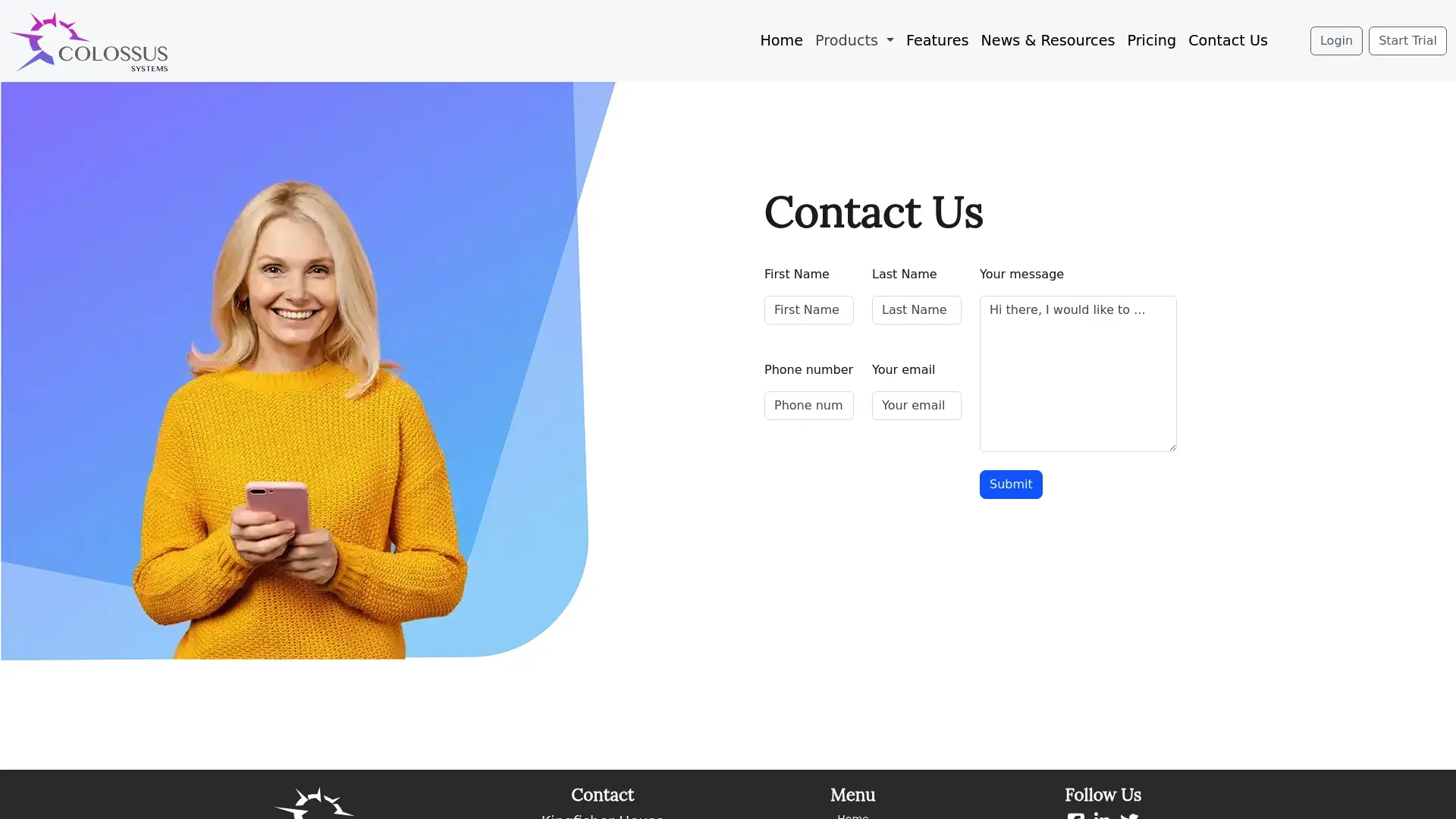Effective Stress Management for Leaders: Master Your Resilience

Leadership stress can feel relentless, with deadlines, team pressures, and high expectations colliding daily. Yet, many leaders admit they have never actually documented their top stress triggers in any organised way. Most assume the chaos just comes with the job, but they miss a surprising truth. Once you can clearly map out your own personal stress patterns, it becomes far easier to break the cycle and build lasting resilience.
Table of Contents
- Step 1: Identify Your Stressors
- Step 2: Develop A Personal Stress Management Plan
- Step 3: Implement Mindfulness Practices
- Step 4: Foster Open Communication With Your Team
- Step 5: Monitor Progress And Adjust Techniques
Quick Summary
| Key Point | Explanation |
|---|---|
| 1. Identify Your Stress Triggers | Understand what causes your stress by documenting experiences and reactions in a stress journal. |
| 2. Develop a Personalised Stress Management Plan | Create a strategic plan tailored to your stressors, integrating techniques for mental, physical, and emotional resilience. |
| 3. Implement Mindfulness Practices | Regular mindfulness exercises help you manage stress proactively and enhance emotional clarity. |
| 4. Foster Open Team Communication | Encourage transparent discussions about stress within your team to build support and empathy. |
| 5. Monitor and Adjust Strategies Regularly | Continuously evaluate and refine your stress management techniques based on their effectiveness and your changing needs. |
Step 1: Identify Your Stressors
Leadership stress management begins with a critical first step: understanding precisely what triggers your stress responses. Most leaders struggle with stress not because challenges are insurmountable, but because they have not systematically mapped their unique stress landscape.
The process of identifying stressors requires honest self-reflection and careful observation. Start by creating a comprehensive stress journal where you document daily experiences that generate tension, anxiety, or emotional overwhelm. Write down not just events, but your immediate emotional and physiological reactions. Note the context, your thoughts, and bodily sensations during these moments.
As the U.S. Department of Veterans Affairs suggests, stressors can emerge from both positive and negative events. Leadership challenges might include high-stakes decision making, team performance pressures, interpersonal conflicts, tight deadlines, resource constraints, or personal expectations of excellence.
To effectively track your stressors, consider categorizing them into specific domains:
- Professional triggers (workplace dynamics, project complexities)
- Personal expectations (self-imposed standards, work-life balance)
- Relational challenges (team management, stakeholder interactions)
- External pressures (organizational changes, market uncertainties)
As you document these experiences, look for patterns. Which scenarios consistently produce the most significant stress responses? Are there specific times of day, types of interactions, or recurring situations that heighten your anxiety? This pattern recognition is crucial for developing targeted stress management strategies.
The following table summarises common domains of leadership stressors and provides examples, helping leaders organise and recognise their personal stress triggers more effectively.
| Stressor Domain | Typical Examples |
|---|---|
| Professional triggers | Workplace dynamics, project complexities |
| Personal expectations | Self-imposed standards, work-life balance |
| Relational challenges | Team management, stakeholder interactions |
| External pressures | Organisational changes, market uncertainties |
| High-stakes decision making | Critical business choices with significant consequences |
| Resource constraints | Limited staffing, budget or time |
| Performance pressures | Meeting targets, quality benchmarks |
Successful identification means you can articulate your stressors with precision. The goal is not to eliminate stress entirely, but to understand its sources and develop resilient responses. By the end of this step, you should have a clear, written inventory of your primary stress triggers, allowing you to move forward with strategic mitigation techniques.

Step 2: Develop a Personal Stress Management Plan
Transforming your understanding of stress triggers into a structured, actionable plan requires strategic thinking and personalized approaches. A robust stress management plan is not a one-size-fits-all solution but a dynamic framework tailored to your unique leadership challenges and personal resilience capabilities.
Begin by translating your stress journal insights into specific, measurable strategies. Prioritize interventions that address your most significant stressors with targeted techniques. This might involve establishing clear boundaries, redesigning workflow processes, or developing specific communication protocols that mitigate potential tension points.
As the Substance Abuse and Mental Health Services Administration recommends, building personal resilience requires a holistic approach. Your plan should encompass physical, mental, and emotional dimensions of stress management. Consider integrating regular exercise, mindfulness practices, nutrition strategies, and sleep hygiene into your routine.
Design your plan with realistic, incremental goals. Create a structured weekly framework that includes dedicated time for self-care, reflection, and stress recovery. Your schedule might incorporate specific blocks for meditation, physical activity, professional development, or personal hobbies that help reset your mental state.
Your stress management toolkit should include multiple intervention strategies:
- Immediate coping mechanisms (deep breathing, short meditation)
- Medium-term resilience building (weekly counseling, skill development)
- Long-term lifestyle adjustments (work-life balance redesign)
Remember that flexibility is key. A good stress management plan evolves with your changing leadership responsibilities. Regularly review and adjust your strategies, tracking what works and what requires modification. For leaders interested in optimizing their approach, explore our comprehensive time management guide for additional productivity insights.
Successful implementation means you have a clear, personalized roadmap for managing stress proactively. Your plan should feel supportive, not restrictive, empowering you to navigate leadership challenges with greater emotional intelligence and professional composure.
Step 3: Implement Mindfulness Practices
Mindfulness transforms stress management from a reactive approach to a proactive strategy, enabling leaders to cultivate emotional resilience and cognitive clarity. Unlike traditional stress reduction techniques, mindfulness empowers you to interrupt negative thought patterns and respond to challenges with greater intentionality and composure.
Mindfulness is not about eliminating stress, but developing a skillful relationship with your inner experience. Begin by establishing a consistent daily practice, even if it starts with just five minutes. The most effective mindfulness approaches are those integrated seamlessly into your existing routine, making them sustainable and practical for busy leaders.
As the Washington State Employee Assistance Program suggests, breathing techniques form the cornerstone of mindful practice. Practice box breathing: inhale for four counts, hold for four counts, exhale for four counts, and pause for four counts. This technique resets your nervous system, reducing cortisol levels and creating mental space during high-pressure moments.
Consider creating dedicated mindfulness moments throughout your workday. These might include brief meditation sessions before important meetings, mindful walking between appointments, or short grounding exercises when transitioning between tasks. **The key is consistency and gentle persistence, not perfection.
Use the table below to review mindfulness techniques already described in the article, along with their core purposes to assist in selecting suitable daily practices for leadership stress management.
| Mindfulness Practice | Purpose |
|---|---|
| Breath-focused meditation | Reduces anxiety, anchors attention |
| Body scan techniques | Releases physical tension |
| Box breathing | Resets nervous system, calms mind |
| Visualisation exercises | Supports emotional regulation |
| Gratitude journaling | Shifts perspective, increases positivity |
| Mindful listening | Improves team interactions and empathy |
| Mindful walking | Provides grounding during transitions |
Your mindfulness toolkit should include multiple practices:
- Breath-focused meditation (5-10 minutes daily)
- Body scan techniques for physical tension release
- Visualization exercises for emotional regulation
- Gratitude journaling to shift perspective
- Mindful listening during team interactions
Technology can support your mindfulness journey. Explore meditation apps, use timer features for structured practice, or set gentle reminders that prompt brief moments of awareness. Learn more about optimizing your professional development with our time management resources.
Successful mindfulness implementation means you can recognize stress triggers without becoming entangled in them. You will develop the ability to observe your thoughts and emotions with curiosity and compassion, creating a powerful leadership skill of emotional intelligence and self-regulation.
Step 4: Foster Open Communication with Your Team
Effective stress management transcends individual practices and requires creating an organizational culture of transparency, empathy, and mutual support. Open communication becomes the critical bridge between personal resilience and collective team strength, transforming potential stress points into opportunities for growth and connection.
As the Substance Abuse and Mental Health Services Administration highlights, proactive communication strategies are essential for managing team stress. Begin by establishing regular check-in mechanisms that go beyond traditional performance reviews. These might include weekly team huddles, monthly stress assessment discussions, or informal coffee conversations designed to create psychological safety.
Leaders must model vulnerability and emotional intelligence. Share your own stress management experiences candidly, demonstrating that acknowledging challenges is a sign of strength, not weakness. This approach normalizes stress discussions and encourages team members to seek support without fear of judgment. Create an environment where emotional well-being is as important as professional performance.
Develop communication protocols that provide multiple channels for team members to express concerns. Some individuals prefer direct conversations, while others might feel more comfortable using anonymous feedback systems or digital communication platforms. For insights on managing diverse communication styles, explore our guide on remote team interactions.
Your communication strategy should include:
- Regular structured check-ins
- Anonymous feedback mechanisms
- Peer support network development
- Stress resilience workshops
- Clear escalation paths for addressing workplace challenges
Pay attention to nonverbal communication signals. Learn to recognize subtle signs of stress in your team members, such as changes in work patterns, decreased engagement, or increased irritability. Approach these observations with compassion and a genuine desire to understand and support.
Successful implementation means your team views communication as a collaborative tool for collective well-being. You will have created an environment where stress is not a taboo topic, but a shared challenge to be navigated together with empathy, understanding, and proactive support.

Step 5: Monitor Progress and Adjust Techniques
Stress management is not a static process but a dynamic journey of continuous learning and adaptation. Effective leaders understand that their stress management strategies must evolve with changing professional landscapes and personal experiences. This step focuses on developing a systematic approach to tracking, evaluating, and refining your stress resilience techniques.
As the Substance Abuse and Mental Health Services Administration recommends, monitoring progress requires establishing clear, measurable indicators of your emotional and psychological well-being. Create a weekly reflection journal that tracks key metrics such as sleep quality, energy levels, emotional reactivity, and overall job satisfaction. This documentation provides tangible evidence of your stress management effectiveness.
This table offers a comparison of different stress monitoring tools and methods mentioned, outlining their intended use to help leaders evaluate their progress over time.
| Monitoring Method | Intended Use |
|---|---|
| Weekly reflection journal | Track sleep quality and energy, review emotions |
| Quantitative stress level tracking | Measure changes in perceived stress levels |
| Standardised self-assessment | Provide quantifiable mental health data |
| Emotional response journal | Record feelings and reactivity |
| Physical health indicators | Monitor changes in health and wellbeing |
| Professional performance metrics | Assess impact of stress on work output |
| Trusted colleague feedback | Gain external perspective on behaviour changes |
Implement a structured self-assessment process that goes beyond subjective feelings. Use standardized stress assessment tools or psychological wellness questionnaires to generate quantifiable data about your mental health. These assessments help identify patterns, track improvements, and highlight areas requiring immediate attention.
Your monitoring toolkit should include multiple evaluation methods:
- Quantitative stress level tracking
- Emotional response journal
- Physical health indicators
- Professional performance metrics
- Feedback from trusted colleagues
Adaptability is the cornerstone of successful stress management. Be prepared to pivot your strategies when current approaches no longer serve your needs. This might mean replacing meditation with yoga, adjusting work boundaries, or seeking professional counseling. For comprehensive insights into staff development and training strategies, explore our professional resources.
Critical to this process is maintaining a growth mindset. View each stress management technique as an experiment, not a fixed solution. Some strategies will work brilliantly for months, while others might become less effective over time. Regular recalibration prevents stagnation and ensures your stress management approach remains dynamic and responsive.
Successful implementation means you have transformed stress management from a reactive process to a proactive, data-driven personal development strategy. You will have created a responsive system that supports your continuous emotional and professional growth, turning potential challenges into opportunities for resilience and self-improvement.
Transform Leadership Stress Into Organisational Growth
Are recurrent leadership pressures and the relentless pace of membership management leaving you overwhelmed or stuck in crisis mode? If the stressors described in our guide on stress management resonate with you—from navigating high-stakes decisions to juggling member expectations—know that you are not alone. Mastering your resilience as a leader is about more than personal habits. It requires the right systems and support to translate strategy into lasting change.

Colossus Systems empowers you to turn self-awareness and mindful leadership into real competitive advantage. Our unified platform streamlines member management, event organisation, communications, and analytics so you have more time and clarity to focus on what truly matters—leading with purpose and growing your community. Now is the time to move from reactive stress management to proactive leadership excellence. Discover how our solutions for membership-based organisations can help you reduce daily pressures, boost engagement, and create a more resilient team. Connect with our team today to experience the difference and take the next step towards scaling your impact.
Frequently Asked Questions
What are the first steps in identifying my stressors as a leader?
Begin by keeping a stress journal where you document daily experiences that generate tension, anxiety, or emotional overwhelm. Note your emotional and physiological reactions, context, and thoughts during stressful moments to help recognise patterns in your stress responses.
How can I develop a personalised stress management plan?
Transform insights from your stress journal into specific, measurable strategies. Prioritise interventions that address your most significant stressors, and ensure your plan includes a mix of immediate coping mechanisms, medium-term resilience-building techniques, and long-term lifestyle adjustments.
What mindfulness practices can help leaders manage stress effectively?
Incorporate brief daily mindfulness practices such as breath-focused meditation, body scans for tension release, and gratitude journaling. These techniques help create mental space and emotional clarity, enabling proactive stress management.
Why is open communication important in managing stress within a team?
Open communication fosters an environment of transparency and support, allowing team members to share their stressors without fear of judgment. This collective approach transforms potential stress points into opportunities for growth and connection, enhancing overall team resilience.
Recommended
- 7 Essential Leadership Skills for Students to Develop|CS
- Understanding Leadership Development Strategies | Colossus Systems
- Mastering Public Speaking for Leaders: A Step-by-Step Guide|CS
- Effective Time Management Tips for 2025 Success | Colossus Systems
- How to Foster Innovation: Practical Steps for Leaders